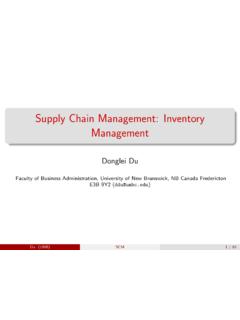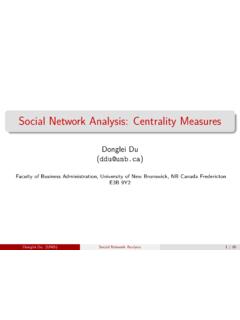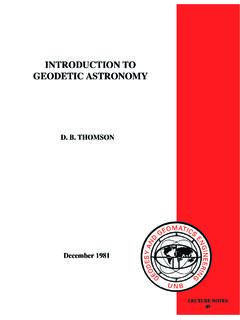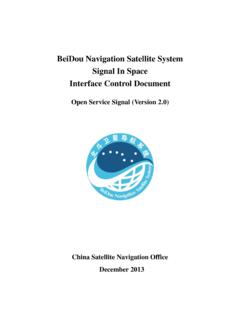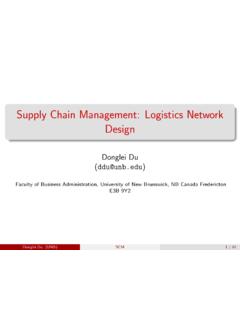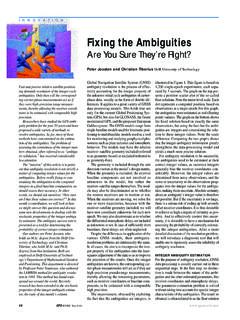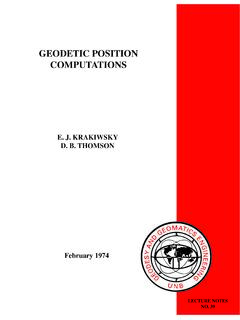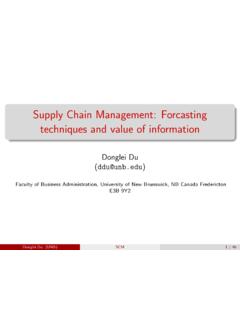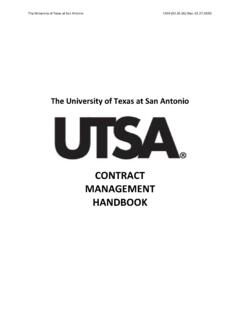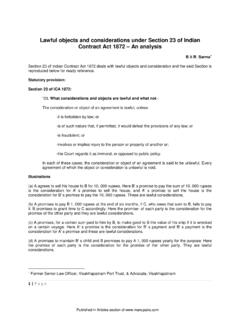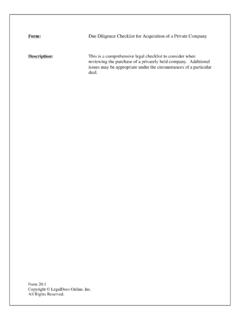Transcription of Supply Chain Management: Contract
1 Supply Chain Management: ContractDonglei of Business Administration, University of New Brunswick, NB Canada FrederictonE3B 9Y2 Donglei Du (UNB)SCM1 / 48 Table of contents I1 Introduction2 Price-only contractA Case Swimsuit Production3 The Buy-back Contract4 The Revenue-sharing Contract5 Some other contracts6 Discusion and comparisonDonglei Du (UNB)SCM2 / 48 Section 1 IntroductionDonglei Du (UNB)SCM3 / 48 Supply Chain ContractSupply Chain Contracts are agreement between buyer andsupplier on issues likePricing and volume and maximum purchase lead or material return will use the Newsboy model to address the Supply chaincontract. Earlier we model the Newsboy problem as acost-minimization problem.
2 It can also be equivalently modeledas a profit-maximization problem, which is more convenient forthe discussion of Supply Chain Du (UNB)SCM4 / 48An Illustrative Example of Supply Chain Contract IThe set up: To set up a uniform framework for discussion ofsupply Chain contracts, we introduce the following notations. +=qqqrpSsLpSIEIrr = EIss+= 48476rsII+= qqqSqLqXqqXS = +== )( }],[min{EEContractXmqIs =EExternalInternalInternalSupplierRetail erDonglei Du (UNB)SCM5 / 48An Illustrative Example of Supply Chain Contract IIThe profit of the retailer contains two parts: the internal partand the external r=Ir EThe profit of the supplier contains two parts: the internal partand the external r=Is+EThe profit of the system contains only internal parts:maxq s+ r=Is+IrDonglei Du (UNB)SCM6 / 48 Section 2 Price-only contractDonglei Du (UNB)SCM7 / 48 The wholesale price Contract IWe first consider awholesale price Contract .
3 There is onesupplier and a retailer. The Contract between the supplier andretailer can be modeled as a Stackelberg Game:1 The supplier offers the retailer an the retailer rejects, then the game , the retailer submits an orderqto the supplier produces the order at unit manufacturing pricemand delivers to the retailer at unit whole-sale pricew5 Season demands occurs. Unsold items are salvaged at unit payments are transferred between the two firms based onthe agreed Du (UNB)SCM8 / 48 The wholesale price Contract IIThe following assumption is reasonable:Assumptionp > w > m > , the retail price is greater than both the wholesale and the previous framework, thewholesalecontract is specifiedbyE=wqDonglei Du (UNB)SCM9 / 48 Three different points of viewRetailer s View: The retailer wants to maximize its own s View: The supplier wants to maximize its own s View.
4 The system wants to maximize the overall Du (UNB)SCM10 / 48 Retailer s Problem IThe retailer faces uncertain demandXwith cumulativedistribution functionFXand density retailer ordersq(a decision variable) units from the supplierat wholesale retailer sells at retail pricepper unit to salvage price realized expected sales beSq=EX[min{X, q}] =q+EX[min{X q,0}] =q+EX(X q) The expected leftover inventoryLq=EX[q min{X, q}] =q SqDonglei Du (UNB)SCM11 / 48 Retailer s Problem IIThe retailer wants to choose an order quantityqto maximizeher expected profit and in this caseIr=pSq+sLq:Therefore the retailer s problem is the following optimizationproblemmaxq r=Ir E= pSq expected revenue+sLq expected salvage value wq= (p s)Sq+ (s w)q= (p s)EX(X q) + (p w)qDonglei Du (UNB)SCM12 / 48 Retailer s Problem IIIThe optimal order quantity for the retailer isqr=F 1X(p wp s)Donglei Du (UNB)SCM13 / 48 Supplier s ProblemThe supplier producesqunits to deliver to the retailer atwholesale retailer wants to chooseqto maximize his expected profit.
5 Maxq s=Is+E= mq+wq= (w m)qThe optimal order quantityqsfor the supplier is as much aspossible under its capacity Du (UNB)SCM14 / 48 System s ProblemThe system wants to chooseqto maximize its expected overallprofit:maxq[ s+ r] = (p s)Sq+ (s w)q+wq= (p s)Sq+sq= (p s)EX(X q) + (p m)qThe optimal order quantity for the system isq=F 1X(p mp s)Donglei Du (UNB)SCM15 / 48 Compare the three viewsLet us compare the optimal order quantities between the retailerand the system, assuming the supplier has unlimited can shown that the system optimal order quantity is alwaysgreater than that of the retailer optimal:q=F 1X(p mp s)> qr=F 1X(p wp s)The claim above follows by noting thatP(X qr) =p wp s< Assumption1p mp s=P(X q).
6 Donglei Du (UNB)SCM16 / 48 Double marginalization INote thatq=qrif and only ifw=m. This fact illustrates theso-calleddouble marginalizationphenomenon, first identified bySpengler (1950), of the whole-sale price Contract :systemoptimal can be achieved only if the supplier earns no profit thisis impossible in reality!.To summarize, the wholesale price Contract has the followingproperties:SimpleDouble marginalizationThe reason for double marginalization is: the two agents, thesupplier and the retailer are bothselfish(a rational behavior,what do you think!) players in this game. They seek to maximizetheir own profits without caring for the system Du (UNB)SCM17 / 48 Double marginalization IINow the question arises on whether there exists Supply chaincontract which achieves system optimal under the assumptionthat both supplier and retailer are selfish.
7 A Supply Chain iscalledcoordinatedif there exists a Supply Chain Contract that issystem optimal. We will discuss some coordinated Supply chaincontracts Du (UNB)SCM18 / 48 Subsection 1A Case Swimsuit ProductionDonglei Du (UNB)SCM19 / 48A Case Swimsuit Production IGiven a simple one-supplier-one-retailer Supply Chain model withthe cost structures:m= $35 :production unit costw= $80 :supplier wholesale pricep= $125 :retailer selling prices= $20 :retailer salvage priceThe demand facing the Supply Chain is given below:Demand Scenarios0%10%20%30%8000 10000 12000 14000 16000 Du (UNB)SCM20 / 48A Case Swimsuit Production IIDemand in tableXP(X)8, , , , , are the expected optimal profits and order quantities forthe supplier, the retailer and the system?
8 Donglei Du (UNB)SCM21 / 48 Analysis of the Case IRetailer s optimal order quantity is 12,000 units (also showed inthe graph below), obtained asPr(X qr) p wp s=125 80125 20=45105 12,000 Expected Profit0100000200000300000400000500000600 0 8000 10000 12000 14000 16000 18000 20000 Order QuantityDonglei Du (UNB)SCM22 / 48 Analysis of the Case IIRetailer s expected profit is $470,700, obtained as r= (p s)EX(X q) + (p w)q= 105EX(X 12000) + 45(12000)= 105[ (8000 12000) + (10000 12000)]+45(12000) = 470,700 Supplier profit is $540,000, obtained as s= (w m)qr= (80 35)12000 = 540,000 Supply Chain Profit is $1010,700, obtained as = r+ s= 470,700 + 540,000 = 1010,700 Donglei Du (UNB)SCM23 / 48 Analysis of the Case IIIH owever, the optimal system order quantity isPr(X q) p mp s=125 35125 20=90105 16,000with a total profit of 1014,500, obtained as(p s)EX(X q) + (p m)q= 105[ (8000 16000) + (10000 16000)+ (12000 16000) + (14000 16000)]+90(16,000)= 105( 3100) + 90(16000) = 1114,500 Donglei Du (UNB)SCM24 / 48 Analysis of the Case IVThis means the wholesale price Contract did not achieve thesystem optimal.
9 Now the question is:Is there anything that theretailer and supplier can do to increase the profit of both?Donglei Du (UNB)SCM25 / 48 Section 3 The Buy-back ContractDonglei Du (UNB)SCM26 / 48 The Buy-back Contract IThe Buy-back Contract : The Contract is specified by threeparameters(q, w, b), whereb > s. The suppliercharges the retailerwper unit purchased, but paysthe retailerbper unit for any unsold bLqNow the new profit distribution picture is given by (and in thiscaseIr=pSq: no need to salvage the leftover at the retailer,the supplier will buy back them, andIs= mq+sq: since thesupplier will salvage the unsold at pricesDonglei Du (UNB)SCM27 / 48 The Buy-back Contract II r=Ir E=Ir (wq bLq)= (p b)EX(X q) + (p w)q s= (s m)q+wq bLq= (b s)EX(X q) + (w m)q s+ r= (p s)EX(X q) + (p m)qDonglei Du (UNB)SCM28 / 48 The Buy-back Contract IIIU nder this Contract , the system order quantity isq=F 1X(p mp).)
10 Now the retailer has the incentive to order more, his optimalorder quantity becomesqr=F 1X(p wp b) buy-back order> F 1X(p wp s) wholesale orderDonglei Du (UNB)SCM29 / 48 The Buy-back Contract IVGiven all the parametersp > w > m > s, we can choosebsuchthat the retailer order up to the optimal system quantityq:p wp b=p mp b=p(w m)p mDonglei Du (UNB)SCM30 / 48 The Swimsuit Production Case continued ISuppose the supplier offers to buy unsold swimsuits from theretailer forb= $55. Under this buy-back Contract , we want toknow what the expected optimal profits and order quantities forthe supplier, the retailer and the system are?We can apply the formulas from the the previous discussionanswer the questions s optimal order quantity is 14,000 units (also showed inthe graph below), obtained asPr(X qr) =p wp b=125 80125 55=4570 Du (UNB)SCM31 / 48 The Swimsuit Production Case continued IISoqr= 14,000,andEX(X q) =EX(X 14000) = (8000 14000)+ (10000 14000)+ (12000 14000)= 1660 Retailer s expected profit is $513,800, obtained as r= (p b)EX(X q) + (p w)q= 70( 1660) + 45(14000)= 513,800 Donglei Du (UNB)SCM32 / 48 The Swimsuit Production Case continued IIIS upplier profit is $538,700, obtained as s= (b s)EX(X qr) + (w m)qr= (55 20)( 1660) + (45)
